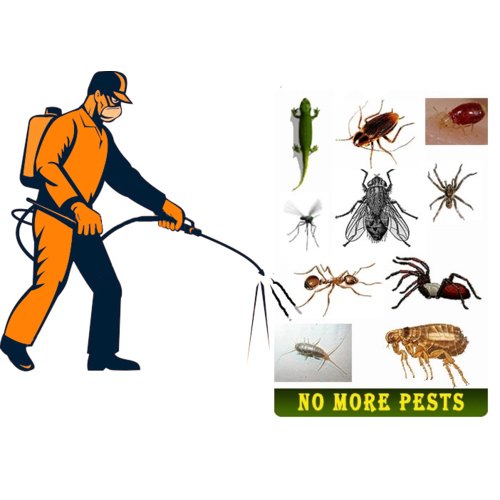Complete Services from Pest Control Lockhart for Any Infestation
Wiki Article
Exploring Problem and Treatment Approaches in the Globe of Insect Control
The landscape of insect control encompasses a myriad of challenges, especially as infestations of usual home parasites remain to develop. Recognizing the actions and reproductive patterns of these annoyances is important for creating efficient therapy techniques. By incorporating preventive actions with sophisticated administration strategies, such as Integrated Insect Monitoring (IPM), homeowners can much better guard their atmospheres. Nonetheless, the efficiency of these approaches may differ dramatically based on certain conditions. What hidden variables add to the success or failure of these methods in different setups?
Usual Home Pests
When it comes to managing our living spaces, understanding typical house insects is crucial. These insects not only disrupt our comfort but can also position health threats and damage building. One of the most common household pests include ants, roaches, rodents, termites, and bed pests.Ants, frequently seen foraging in kitchens, can pollute food and develop big colonies. Rodents, including computer mice and rats, can cause structural damage and carry illness like hantavirus and salmonella.
Acknowledging the signs of these parasites, such as droppings, nests, or attack marks, is essential for early treatment (Pest Control Lockhart). Appropriate sanitation techniques, securing entrance points, and maintaining a clutter-free setting are effective preventative measures. By determining these typical family bugs and recognizing their habits, homeowners can take positive steps to mitigate infestations, guaranteeing a much healthier living setting
Understanding Pest Infestations
Insect invasions can escalate swiftly, turning a minor aggravation into a considerable trouble if not resolved quickly. Typical factors contributing to infestations include inadequate sanitation, architectural susceptabilities, and seasonal modifications that drive pests inside.Determining the kind of parasite is important, as various species show varied behaviors and reproductive rates. As an example, rats might develop nests in surprise areas while insects like cockroaches prosper in wet atmospheres. Early discovery typically rests on identifying indicators such as droppings, gnaw marks, or unusual sounds, which can show a problem prior to it becomes extreme.
Cozy, humid climates can promote the rapid development of parasite populations, while modifications in landscape design or construction can accidentally create favorable settings. An informed method to recognizing these characteristics lays the groundwork for efficient parasite management techniques in the future.
Therapy Approaches and Techniques
Efficient therapy approaches and strategies are important for alleviating parasite infestations and restoring a risk-free atmosphere. A complex approach is often best, integrating chemical, organic, and mechanical approaches tailored to the particular bug and the intensity of the problem.Chemical therapies consist of using pesticides and herbicides, which can effectively eliminate bugs. Correct application and adherence to safety and security standards are critical to decrease threats to human beings and non-target microorganisms. Integrated Bug Administration (IPM) motivates the cautious use of chemicals as a last hope, relying rather on surveillance and limit levels to determine intervention demands.
Organic control techniques include introducing natural killers or parasites to minimize bug populations. This strategy is significantly preferred, especially in agricultural settings, as it promotes ecological sustainability.
Mechanical techniques, such as catches and barriers, provide prompt remedy for bugs without introducing chemicals. Options include sticky catches for pests or physical barriers for rats.
Ultimately, the choice of treatment technique should consider the specific parasite, the setting, and possible influences on human wellness and environments. A well balanced combination of these approaches can successfully manage invasions while advertising long-term parasite control services.
Safety Nets for House
Proactively dealing with bug concerns before they intensify is vital for maintaining a healthy and balanced home setting (Pest Control Lockhart). Implementing efficient preventative measures can considerably minimize the chance of infestations, ultimately protecting both your residential or commercial property and wellness
Proper landscaping additionally plays a crucial role in avoidance. Maintaining hedges and trees cut away from your house lowers the opportunities of bugs discovering their method inside your home. Additionally, guarantee that drainage systems are functioning successfully to stop standing water, which can reel in insects and various other bugs.
Finally, regular examinations are suggested. Regularly inspecting for indicators of bug activity allows for very early treatment. By taking on these safety nets, homeowners can produce an environment that is less friendly to bugs, thus boosting their general lifestyle and lowering the need for considerable bug control interventions.
Business Parasite Control Strategies
Home Page A detailed approach to business insect control is essential for services aiming to maintain a safe and hygienic setting. Effective methods involve a mix of normal evaluations, staff member training, and the implementation of Integrated Parasite Management (IPM) methods.Normal evaluations make it possible for early detection of bug task, permitting timely treatment. Services should establish a regular timetable for these analyses, focusing on high-risk areas such as cooking areas, storage space rooms, and waste disposal websites. Staff member training is equally important; team needs to be educated on the signs of insect invasions and the relevance of reporting them immediately.
Executing IPM practices assists alleviate bug concerns sustainably. This consists of environment alteration, such as securing access factors and lowering mess, along with using all-natural deterrents prior to considering chemical therapies.

In addition, teaming up with a qualified parasite control service provider guarantees access to expert knowledge and advanced therapy alternatives. This collaboration can cause personalized bug control prepares tailored to the specific demands of the business, lessening threats and boosting general effectiveness. Ultimately, a proactive and enlightened technique promotes a pest-free environment, guarding both public wellness and company credibility.
Conclusion
Finally, efficient insect control necessitates a thorough understanding of typical family helpful hints pests and their habits, combined This Site with targeted treatment methods. Applying safety nets alongside therapy techniques such as Integrated Parasite Administration and organic control enhances the capacity to reduce infestations. Routine inspections and a mix of chemical and mechanical services better add to keeping pest-free environments. Inevitably, a well-rounded strategy to pest management is crucial for protecting living rooms from unwanted trespassers.Report this wiki page